Calculate the force experienced by a 3.5 kg object sitting on a frictionless incline of 30o
Answer: 17.15 N
Determine the force acting between a 3 C and -1.5 C pair of charges that are 4cm apart
Using Coulomb's Law
r = 0.04, q1 = 3, q2 = -1.5
2.5x1013 N
Explain why no object with mass can travel at the speed of light.
Because as v approaches c, momentum approaches infinity.
OR
Because as v approaches c, energy/work required to accelerate further approaches infinity.
DEDUCT POINTS FOR SAYING MASS APPROACHES INFINITY
Calculate the maximum kinetic energy of a photoelectron ejected from aluminium (W = 6.5x10-19J) if the incident frequency of light is 1.3x1015 Hz
2.11x10-19 J
List the six types of quarks
Up down top bottom strange charm
A planet orbits the star Sirius at an average radius of 3 AU over a period of 3.62 Years.
A second planet is 12 AU away form the star, what is it's orbital period?
Answer: 28.94 years
Two wires, 1 and 2 are placed 15 cm apart. Wire 1 has a current of 3.0 A downwards, and Wire 2 has a current of 2.5 A upwards. Determine the magnetic field 10 cm away from Wire 1.
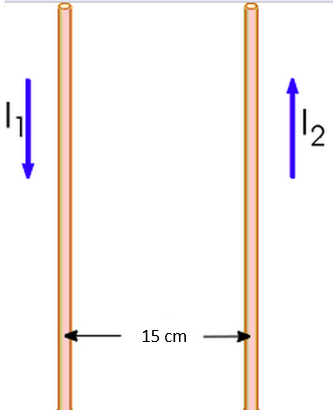
B = B1 + B2
=
=\mu_0/(2\pi)(I_1/r_1+I_2/r_2 )=\mu_0/(2\pi)(3.0/0.1+2.5/0.05)=1.6\times 10^(-5) T
Alice is traveling in a spaceship at 0.69c. On her watch the journey takes 4.20 years.
Bob remains on earth and also times her journey. Determine how long the journey takes according to Bob's measurements.
t0 = 4.20
bob's time is t = 5.8 years
Calculate the momentum of a photon with a frequency of 5.3x1014 Hz
1.17x10-27 kgm/s
State the four gauge bosons and the fundamental force they mediate.
Photon - electromagnetic force
Gluon - Strong nuclear force
W - Weak Nuclear Force
Z - Weak Nuclear Force
Deduce the acceleration due to gravity at the surface of the moon given that it's mass is 1/80 that of Earth and its diameter is 1/4 that of Earth.
gm=0.2ge = 1.96 m/s2
An electron enters a magnetic field pointing into the page at a speed of 300 m/s and travels in a circular path with a radius of 5 cm.
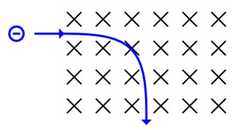
A second electron is shot into the same magnetic field with a speed of 125 m/s. Determine the radius of the new path.
0.0208 m or 2.08 cm
using mv^2/r = qvB
the ratio v/r is constant and can be used to determine r
A cosmic ray travels 60 km through the Earth's atmosphere in 400 microseconds, as measured by experimenters on the ground.
How long does this take in the cosmic ray's reference frame?
v = 60000/400x10-6 = 1.5x108 m/s or 0.5c.
time given is dilated time
using time dilation formula
t0 = 346 microseconds.
An excited electron in a Hydrogen atom relaxes from the fifth excited state to the first excited state.
Calculate the energy of light released in eV.
Answer: 3.02 eV
Using Rydberg formula with ni = 6 and nf = 2
To get wavelength, then use E = hf to get energy
Convert energy to eV
State two conservation laws relevant to the standard model.
Conservation of baryon number
Conservation of lepton number
A satellite moves in a circular orbit around earth at a speed of 6100 m/s.
Determine the period of the satellite's orbit.
(M earth = 6x1024 kg)
Answer: 11078 s
About 3 hours.
Combine formulas for gravitational acceleration with centripetal acceleration and velocity vs period formula.
The diagram shows an electric circuit in a magnetic field directed into the page. The graph shows how the flux through the conductive loop changes over a period of 12 seconds.
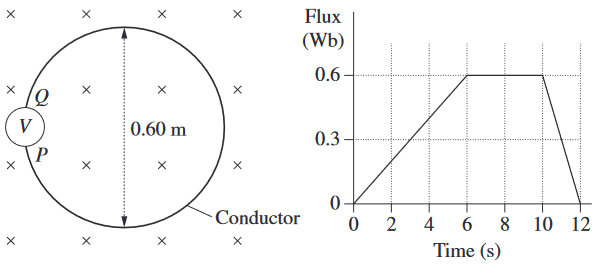 Determine the maximum voltage induced through the loop during this time, and the polarity of the terminals Q and P when this occurs.
Determine the maximum voltage induced through the loop during this time, and the polarity of the terminals Q and P when this occurs.
Max V = steepest gradient.
V = emf = -(0.6-0)/2 = 0.3 V
By Lenz's law - induced current will be anti-clockwise. This will cause positive charges to accumulate at P. Therefore P will be positive and Q will be negative.
You are flying in a personal rocketcraft gifted to you by Mr Bezos, lord of an unnamed shopping empire, himself. You are traveling at 0.9c from Star A to Star B. The distance between the stars, in the stars' reference frame, is 1.0 light years. At the instant you are halfway through your journey they both explode simultaneously in your reference frame.
Do you see both stars explode at the same time? If not, which do you see first, and what is the time difference between the two.
The light from each explosion would reach you at the same time.
In your reference frame you are not moving and they both explode simultaneously which means the light has equal distances to travel.
An experiment was conducted to determine the work function of an unknown metal. The voltage across a photocell was modified and the current recorded for a constant input light frequency.
The setup and graph are shown below.
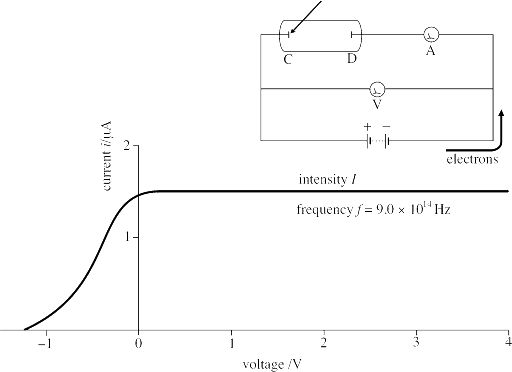
Determine the work function of the metal.
Answer: 4.04x10-19 J or about 2.53 eV
X-intercept is stopping voltage (About -1.2 V)
Ekmax = qVs = hf - W
W = hf - qVs
Compare the fundamental forces experienced by quarks and leptons.
Similar:
Quarks are charged and so are some leptons, these will experience the electromagnetic force.
Both experience the weak nuclear force.
Different:
Quarks experience the strong nuclear force whereas leptons do not.
A 0.5 kg ball is launched from the position shown in the diagram at an angle of 30o to the ground with an initial velocity of 4 m/s. It travels along the friction-less semi-circular wall landing opposite the launch position.
Calculate the net force on the ball during it's flight.
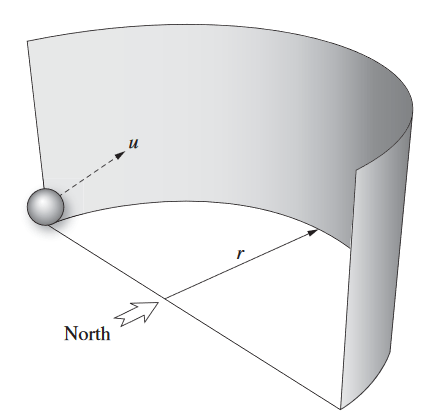
Answer: 14.2 N
Process:
work out vertical and "horizontal" velocity. Find the time of flight, use that to work out the "horizontal" distance - the circumference. Use circumference to work out radius. Use radius to work out centripetal force. Determine net force using pythagoras
The diagram shows electrons traveling in a vacuum at 5.2x104 m/s. They enter an electric field of 10 N/C.
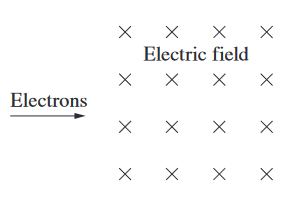
A magnetic field is applied so that the electrons continue through undeflected.
Calculate the magnitude and direction of the magnetic field. Assume gravity is irrelevant.
from qE=qvB
B = 0.0002T up the page.
The length of a spaceship is measured by an observer to be 3.57 m as the spaceship passes by with a velocity of 0.7c.
At what velocity would the spaceship be moving relative to the observer if its measured length was 2.5 m?
Answer: 0.866c
Process: Use LC formula to find proper length for original velocity
Then use new relativistic length + proper length to find velocity
Light of frequency 8.7x1014 Hz is incident on the surface of a metal in a photocell.
THe surface area of the metal is 9.0x10-6 m2 and the intensity of the light is 1.1x10-3Wm-2.
Determine the maximum possible magnitude of the resultant photocurrent.
answer: 2.7 nA.
Process: work out energy of one photon.
Multiply intensity by area to get power. Multiply power by time to get energy (let time be 1 s).
Divide energy by energy of one photon to work out number of photons.
Multiply number of photons by charge of electron to get current.
Explain the particle interaction shown in the Feynman Diagram.
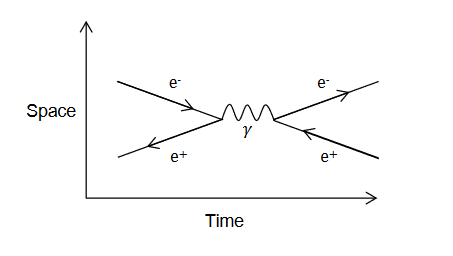
It is Electron-positron annihilation.
This occurs when an electron and positron meet and do not scatter.
The particles annihilate, producing a photon with energy equal to their mass, and then later an electron-positron pair is produced.